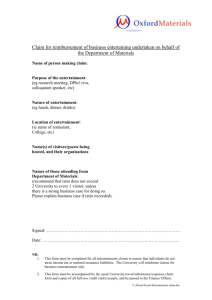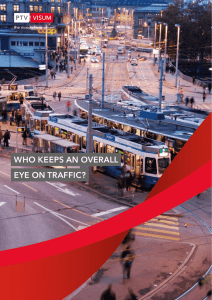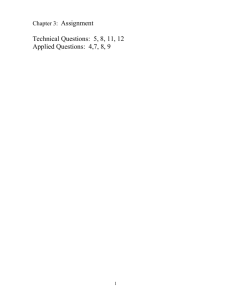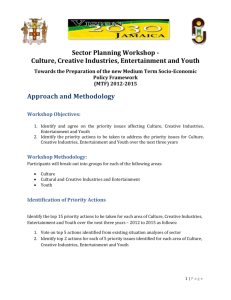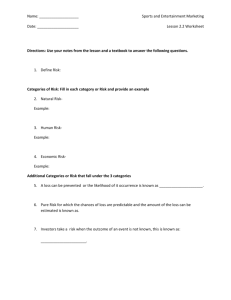Asian Journal of Empirical Research
advertisement
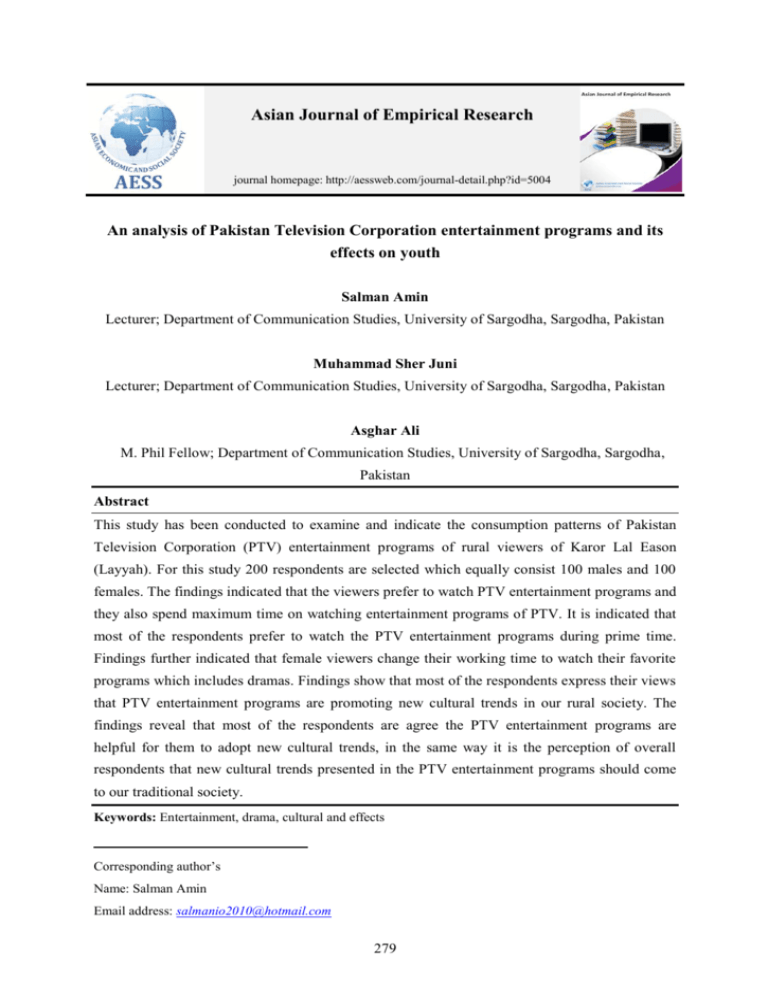
Asian Journal of Empirical Research journal homepage: http://aessweb.com/journal-detail.php?id=5004 An analysis of Pakistan Television Corporation entertainment programs and its effects on youth Salman Amin Lecturer; Department of Communication Studies, University of Sargodha, Sargodha, Pakistan Muhammad Sher Juni Lecturer; Department of Communication Studies, University of Sargodha, Sargodha, Pakistan Asghar Ali M. Phil Fellow; Department of Communication Studies, University of Sargodha, Sargodha, Pakistan Abstract 1 This study has been conducted to examine and indicate the consumption patterns of Pakistan Television Corporation (PTV) entertainment programs of rural viewers of Karor Lal Eason (Layyah). For this study 200 respondents are selected which equally consist 100 males and 100 females. The findings indicated that the viewers prefer to watch PTV entertainment programs and they also spend maximum time on watching entertainment programs of PTV. It is indicated that most of the respondents prefer to watch the PTV entertainment programs during prime time. Findings further indicated that female viewers change their working time to watch their favorite programs which includes dramas. Findings show that most of the respondents express their views that PTV entertainment programs are promoting new cultural trends in our rural society. The findings reveal that most of the respondents are agree the PTV entertainment programs are helpful for them to adopt new cultural trends, in the same way it is the perception of overall respondents that new cultural trends presented in the PTV entertainment programs should come to our traditional society. Keywords: Entertainment, drama, cultural and effects Corresponding author’s Name: Salman Amin Email address: salmanio2010@hotmail.com 279 Asian Journal of Empirical Research, 4(5)2014: 279-292 Introduction Media has become important part of our daily life and it has become the teacher and role model for the individuals of the society. Media is playing a significant role in the each aspect of human life because it has power to make and break the mind of public. Media is a source of information, which provides the information regarding different social and political issues. According to some social science research media act a personality builder for individuals of any society. In the start of human life the information level of human were limited but new inventions in the field of communication has replaced these limitations regarding access to information. Due to new invention in the field of communication human was updated from each event according in the universe. As television is an advance invention in the field of visual communication and it has created global village. Media helps in bringing the true facts and information of the world in front of our eyes. If there was no media, then there was life but without any information and knowledge (dailyessayandarticle.com). Television is a most popular medium of communication in the globe. As Pakistan television is basic focus of this study and it is telecasting different programs which includes dramas, music and other entertainment based programs. TV dramas are most popular among each age group and these are best and preferred for entertainment. In the history of human culture story telling has been remain the important part which educated the human regarding different social and political issues. But in our today culture, TV is playing the role of storytelling by dramas and other entertainment programs (www.pgs.cam). PTV’s dramas are based on different stories which cover the social aspects and issues. As drama is a product of expression and the people watch the entertainment programs to enjoy ant pass the time. Entertainment is a basic way to educate the people regarding different issues and it also create new trends among the viewers. Different studies conducted on PTV entertainment programs has indicated that these are most popular among the viewers and viewers are much impressed by these programs. Now majority of rural has access to PTV and they are enjoying the different programs of PTV. PTV has become most popular medium of communication among the rural viewers. It is empirically indicated that entertainment programs has created new social issues in the society and has influenced the viewers in different ways. Entertainment programs of TV are helpful to believe and follow the different trends which are presented in different TV shows. The impact of entertainment programs has been observed in the each aspect of human life and people are adopting new cultural trends due to different TV programs. According some researcher TV entertainment programs are third parents for youngsters. For teen age group it has become as a friend which tells them about the reality of life. TV has become basic source for female that how 280 Asian Journal of Empirical Research, 4(5)2014: 279-292 to deals with family members as well as (Zarta, 1998). In some respect TV entertainment programs influence the social patterns of human society. In the field of entertainment PTV is most popular in the rural areas of Pakistan. PTV entertainment programs like drams which are telecasted during prime time are most popular among the viewers. PTV entertainment programs are promoting the new cultural trends new customs among the rural youth (www.Pakaffairs.com). The basic objective of choosing the PTV entertainment programs for research is to indicate that how PTV entertainment programs are effecting on rural with particular focus on rural youth. Entertainment programs has impact on the viewers which influence the individuals as a whole. Different studies (www.comms.dcu.ie; www.wikipedia.com; & Biagi, 2003) have indicated that TV entertainment programs are most well accepted among the viewers. Basic objective of entertainment is to relax the viewers, entertainment programs can also be used educate the viewers regarding different issues which are existing in our society. It is mostly observed that media play a vital and TV dramas are most popular among the female viewers (www.umich.edu; & www.usask.ca). PTV entertainment programs like dramas are presented in the family environment and their main role are given to female as a result they are mostly influenced by dramas and female adopt these trends. Most of the rural watch dramas in night time for entertainment. As Spingel (1992) have indicated that history of TV is actually development in the technology which opened the new ways for economics, sociology and entertainment. Television was not only advance technical invention but it has a power to change the mind of viewers (Nawaz, 2006). It has changed the human life style and created new phenomenon in the human civilization. Female journals in 1950s played their role to teach the female readers that how to decorate their homes now this function is performed by TV entertainment programs. These journals also indicated that TV entertainment programs has strong impact on the viewers’ lives. Television entertainment programs has not only modernized the culture but has changed the each aspect of human society. Mostly TV entertainment programs deals with comedy, talk shows .sports and music shows etc. These programs have changed the all traditional trends of human society. Mostly entertainment based programs are presented during prime time when most of the viewers are in front of TV screen. As PTV network telecast the different entertainment based programs whish most popular among the viewers. In this way PTV is providing different entertainment based programs to gratify the needs of their target viewers. Entertainment programs has changed the human behavior and has created new trends in the globe. Different studies conducted on the impact of entertainment programs on TV and radio in different countries has indicated that these entertainment based programs as impact on the human behaviors and the daily life activities of 281 Asian Journal of Empirical Research, 4(5)2014: 279-292 viewers. Researchers investigated that these programs has also some positive impact on the viewers like how to handles some problems which are occurring in their daily lives. It is the view of some researcher that entertainment based programs are playing vital role the in the socialization of individuals and that socialization refers to different issues of human society (Bandura, 1986). The entertainment based programs are changing the customs and traditions of human society and are introducing new trends which are creating new problems for the human. In television dramas new fashion trends are presented and these trends are blindly followed by female viewers. According to some research studies it has been indicated that TV entertainment programs play the role of opinion leader for the viewers in the adoption of new cultural trends (Rogers, 1999). Overview of Pakistan Television Corporation (PTV) Pakistan Television Corporation Limited (PTV) is a public limited company. All its shares are under the control of Government of Pakistan. The establishment of Pakistan television decided to design such entertainment channel which fulfills all the preferred aspect of a family entertainment in a better manner like drama serials, live morning shows, live telecast and much more which the PTV alone not be able to match up such level. PTV home is the 24 hour family channel. PTV home relay its channels transmission on two networks one is the terrestrial network for the broadcasting Pakistan transmission and other is the satellite network for the broadcasting of worldwide transmission. PTV home is a entertainment based channel of PTV network which telecast the different entertainment based programs like dramas, music shows and morning shows. PTV home is most popular medium due to its popular entertainment programs. Basic reason of the popularity of PTV home is its easy access through simple antenna. PTV has huge viewership in the rural areas of Pakistan. It is the mission of PTV home to provide the healthy entertainment to its viewers and it is considered as family channel. PTV home is producing such entertainment programs which are gratifying the needs of target viewers (http://www.ptv.com.pk/Introduction.asp). Literature review Zarta (1998) studied the customs in her research that are altering day by day due to TV dramas. Researcher examined eleven dramas and analyzed customs which were presented in these dramas. Some customs similar to Pakistani customs and viewers adopt some customs without any judgment and than face different kinds of difficulties like financially problems. Shela (1998) conducted “the research on those dramas which are telecasting from PTV, these dramas puts 282 Asian Journal of Empirical Research, 4(5)2014: 279-292 negative effects on people. Modern life style presented in these dramas and people are impressed to these life styles. As a result most important thing national language is neglected in these dramas and prefers English on Urdu. Najia (2003) stated that due to cable TV people cut their social lives and limited their lives in a room. People are adopting Indian culture. Researcher also founded that female took no interest in news and current affairs programs because they spend most of their time on watching Indian dramas. Saba (1996) founded that due to electronic media social life of persons is changed; now people likes to talk about different plays at food time. They favour to watch plays rather than to present their social activities. Due to electronic media the doubt between student and scholars is revoked. They understand the difficulty to one and other. They exact replicate the method of their very popular actor or actress and their connection with their norms is chopping now. Zinab (2004) asserted that after the appearance of satellite dish people have lot of options about the selection of TV channels. Family gathered round the dining table and enlists in the argument about Indian dramas. Pakistani viewers have started to take up language and life style of Indian dramas and movies even the length of dresses are change now. Dancing tendency is furthermore expanding in our society. Aslam (2006) indicated that Indian media is impacting on Pakistani wedding ceremony traditions. Individuals enjoy when they present ineffective culture like shoes concealed, lap filing etc all these observance are not the part of Muslim heritage whereas these observance were performing in the past. But due to the Indian plays especially these kind of ceremonies become more popular as contrast to past. Saadullah (2009) searched that electronic media of our neighboring country construct anti Islamic and anti Pakistani sentiments amidst Pakistani nation on the name of amusement. In Indian movies spread propaganda against Pakistani equipped forces and portrait Indian equipped detachment as bravest armed detachment of the world. Nazia (2008) discovers that Bollywoodisation has adverse influences on Pakistani culture on the name of amusement. Researcher cited that dance culture evolve amidst young generation of Pakistan. Researcher proposes that vulgar movies and plays should be ostracise which comes from over the border. Nadeem (2001) observes that Pakistani culture is substantially leverage by the culture of India and Middle East nations. With Middle East countries Pakistan has religious likenesses and in the matter of India Pakistani has historic interaction because they were live simultaneously for numerous years. So numerous languages are spoken in Pakistan but national language is Urdu. Researcher furthermore points out the joint family system and distinct family system of Paksitani society. 283 Asian Journal of Empirical Research, 4(5)2014: 279-292 Irum (2008) examines that foreign media programs are putting directly impaction Pakistani media culture. Drama industry, music industry and fashion industry are mislaying their dignity day by day. The life style of Pakistani viewers being eclipsed by foreign media. Their eating customs, getting dressed and language are affecting. Rubab (2007) high lights that Indian TV dramas become the absolutely vital part of people’s life. Particularly females prefer to spend most of their time watching plays on the title of amusement or time pass and ignore their husbands’ outcome family disputes evolve. Researcher furthermore cited that a lot of Hindi phrases are taking up by persons. These plays are destroying the distinct persona of Urdu language. Star plus has become trend setter in Pakistan. Mahwish (2006) points out the influence of highly advanced countries of the world on Pakistani society. These influences change our dressed style, eating stuff and our room setting. Social interactions are effecting by drama culture. Usual life is furthermore changing in contradictory way on the name of fashion”. Adil (2007) analyses that zee TV becomes the well liked whipping boy amidst persons. He said that time is now ripe for PTV to reassess its flaw and it arrives back afresh in viewers. Muhammad (2003) investigated that Pakistani standards are being assaulted and in hazard zone due to Indian and west TV channels. He stress on desires to be preserved, promote and strengthened. Society and culture can be change but in affirmative manner. Aqira (2000) percepts that females prefer to watch satellite channels due to fashion and male watch satellite channels for news. Social lives of individuals have been altered due to said activity they want to watch TV rather than interaction with people. Persons desire to adopt modern life style as they saw on TV and they try to talk English. Shahid (2009) examines a very intriguing issue that media campaigns restore individual’s alternative. Fast food culture appearing in Pakistani society and it is injurious for health. But individuals are changing their customs. On the other hand it places contradictory impacts on localized finances and result inflation. Isha (2009) scrutinizes that Muslim culture and personal crises are extending. Muslim has a powerful history about their standards but annals being altered and important sections being omitted. Indian media is a large-scale cause of this alarming situation. Objectives of the Study 1. To explore the consumption patterns of PTV entertainment programs by the rural viewers. 2. To dig out purpose of watching PTV entertainment programs. 284 Asian Journal of Empirical Research, 4(5)2014: 279-292 3. To determine the extent of liking in the PTV entertainment programs by the rural viewers. 4. To find out the effects of the PTV entertainment programs on the rural youth and their daily routine activities. Methodology To meet the requirement of the study stratified method for specification of the viewers' characteristics is adopted and convenience method is used for collection of data from the target population. Due to resource and time constraints it was not possible for the researchers to collect data from the large population of tehsil Karor. Total 200 respondents are selected which includes 100 male and 100 female viewers of PTV. Babbie (1992) stated that “This practice has the effect of improving the representation of a sample by reducing the degree of sample error”. According to Selltez et al. (1976) “Population is divided into two or more strata in stratified method. This procedure generated and organized population into homogeneous subsets and selected various elements from form each”. Travers (1978) stated that that “Major advantage of this procedure is that it increases accuracy”. According to the requirement of present study pre test was conducted .Its basic objective was to understand the problems in the questionnaire and to overcome the weakness. Findings Findings of present study indicated that there is extreme watching of PTV entertainment programs among rural male and female viewer of Karor Lal Eason (Layyah). The analysis of their preference to PTV entertainment programs indicated that majority of the viewers like to watch the PTV entertainment programs. Viewers expressed their views that PTV dramas are family dramas but their exist a significant difference among the watching habits of viewers of PTV entertainment programs as compared to news and talk shows (Fig. 1). 14 16 100 not at all rarely 20 some what frequently 50 very frequently Figure 1: Watching habits of viewers of PTV entertainment programs 285 Asian Journal of Empirical Research, 4(5)2014: 279-292 100 50 0 27 24 85 28 36 Figure 2: Frequency of watching PTV entertainment programs The figure 2 shows that overall 85% respondents are very frequently exposed from the entertainment base programs of PTV. While 36% respondents are very frequently exposed from the entertainment base programs of PTV followed by somewhat 28%, rarely 24% and not at all 27%. However, watching PTV entertainment programs are relatively more preferred by viewers. 2 hours or more 68 68 1 and ½ hours 1hours 23 28 ½ hours 81 2 hours or more Figure 3: Time spending on watching PTV entertainment programs The comparison of the low and heavy time consumption pattern of PTV entertainment programs reveals that low time spending viewers significantly watch PTV entertainment programs. The viewers who consumed heavy time on watching Urdu dramas are significantly exposed to PTV entertainment programs dramatized programs (fig. 4). 100 80 60 40 20 0 90 39 22 17 not at all Little some what Figure 4: Preference to entertainment programs 286 32 Much very much Asian Journal of Empirical Research, 4(5)2014: 279-292 According to the findings of above table which indicate that 90% of overall respondents prefer to watch PTV entertainment programs as compared to others programs of PTV .In the same way 32% of overall viewers are those who are much exposed from PTV entertainment programs followed by somewhat 22%, little 39% and not at all 17% (fig. 5). Entertainment 43 Both 90 killing time 31 Information about new culture 36 Figure 5: Purpose to watch entertainment programs Findings of above chart indicated that 90% of the overall viewers watch PTV entertainment programs to gain the information about new cultural trends which are presented in the PTV entertainment programs. In the same way 43% of overall respondents watch the PTV just for enjoyment and entertainment while 36% of overall respondents are those who watch PTV to just kill the time (Fig. 6). 72 80 60 55 33 40 24 16 20 0 Not at all Little Somewhat Much Very much Figure 6: Satisfied with new cultural trends Above findings indicated that 72% of overall respondents are much satisfied from the new cultural trends which are presented in the PTV entertainment programs while 33% of the overall respondents are those who are extremely satisfied from the new cultural trends presented on PTV. In the same way 55% of overall respondents are those who not satisfied with new cultural trends presented in the PTV entertainment programs followed by somewhat satisfied 16% and little 24% (Fig. 7). 287 Asian Journal of Empirical Research, 4(5)2014: 279-292 150 108 100 50 16 18 18 Not at all Little Somewhat 40 0 Much Very much Figure 7: Information about new culture According above findings which indicated that it is the view of 108 of over all respondents that they use PTV to gain the information about new cultural trends which are shown in the PTV entertainment programs 40 % of overall respondents are those who watch the PTV entertainment programs extremely to gain the information about new cultural trends followed by 16% not at all (Fig. 8). Not at all 30 39 Little Somewhat 42 28 61 Much Very much Figure 8: Help to adopt new cultural trends Above investigations indicated that 30% of overall respondents are satisfied that PTV entertainment programs are very much help full for them to adopt new cultural trends while 42% of expressed their views that PTV entertainment programs provide much to adopt new cultural trends presented on PTV. On the other hands 61% of overall respondents are those which take little help from the PTV entertainment programs to adopt the new cultural trends followed by somewhat 28% and not at all 39% (Fig. 9). 150 108 100 50 44 30 18 44 0 Not at all Little Somewhat Figure 9: Impressed by new trends 288 Much Very much Asian Journal of Empirical Research, 4(5)2014: 279-292 Research findings indicated that 44% of overall respondents are very much impressed by the new cultural trends presented in the PTV entertainment programs while 33% of overall respondents are those which are much impressed by the new trends presented in the PTV entertainment programs, in the 18% are those which are very little impressed and 44% are those which are not impressed by new trends presented in the PTV entertainment programs (Fig. 10). 100 88 80 60 44 30 40 20 18 20 0 Not at all Little Somewhat Much Very much Figure 10: Affecting our culture When it was asked from the respondents that with what frequency PTV entertainment based programs are affecting your native culture than 88 of the overall respondents indicated that PTV entertainment programs are much affecting our culture while 20 respondents indicated that PTV programs are affecting our culture by presenting new cultural trends. In the same way 30 of overall respondents express their views that PTV programs are affecting our culture at little level followed by 18 somewhat and not at all 44% (Fig. 11). 78 80 46 60 40 28 23 25 20 0 Not at all Little Somewhat Much Very much Figure 11: New cultural trends have come to our society The further indicated that 78% of overall respondents are much agree that new cultural trends presented in the PTV entertainment programs should come our traditional society and 25 % are very much satisfied on the arrival of new cultural trends by PTV entertainment programs. On the 289 Asian Journal of Empirical Research, 4(5)2014: 279-292 other hands 28 % of overall respondents are somewhat satisfied with the arrival of new cultural trends in the society followed by 46% very little and 23% not at all (Fig. 11). Summary and discussion The present research was conducted to indicate the effects of PTV entertainment programs on the rural youth of tehsil Karor Lal Eason (Layyah). According to the amount of variation among the sub groups of respondents which documented their responses, so it can be summarized that majority of viewer like the entertainment based programs of PTV because these programs are gratifying their entertainment needs. An important element which has been indicated during the findings was the times spend by the viewers on watching PTV entertainment programs. It indicated that the viewers spend maximum time on watching the PTV entertainment programs, but variation was observed in term of time spending by the viewers. The viewers significantly spent more time on watching PTV entertainment programs. The findings indicated that the respondents prefer to watch the PTV entertainment based programs instead of others news programs. This situation provided the help to the research question that “The youth is more likely to expose more to the PTV entertainment programs than other programs”. The analysis of the findings further showed that majority of the viewers spent more time and paid more attention to the PTV entertainment programs. Therefore, the empirical findings endorsed the study's hypothesis that ‘more likely the viewers spend more time on PTV entertainment programs. References Adil, A. (2007). Cable TV network. retrieved from http://showbiz.kalpoint.com/modules.php?name=News&file=article&sid=470 Aqira, I. (2000). Effectiveness of satellite channels and impacts on the viewers of Multan city. M.A. Thesis, Mass Communication, B.Z.U. Multan, Pakistan. Aslam, J. (2006). Colorful Indian marriage ceremonies. retrieved from http://www.muslimmarriage-guide.com/indian-marriage-customs.html Babbie, E. (1992). The practice of social research. (6th ed.) pp. 111, 262, Wadsworth Pub. Belmont, California. Biagi (2003). Media Impact, An introduction to mass media (4th edition) Wardsworth Publishing Company, USA. Isha, K. (2009). Muslims in India, identity and security issues. retrieved from http://www.pakspectator.com/muslims-in-india-identity-and-security-issues Joshi, U. (2002). Media research: Cross-sectional analysis. (1st edition) Authors Press, Delhi, India. 290 Asian Journal of Empirical Research, 4(5)2014: 279-292 Kaisar, M. (2005). The effects of electronic media on children ages 0-6. retrieved from www.tvo.org/cfmx/tvoorg/tvoparents/index.cfm?page_id=145&action=article&article_titl e_url=&article_id=1181 Mahwish, F. (2006). Changing life style in Pakistan. Retrieved from http://www.hamariweb.com/article.aspx?id=1168. Muhammad, A. (2003). Media and national stability. Retrieved from culture. Retrieved from http://pakistantimes.net/2003/11/20/guest1.htm. Nadeem, S. (2001). Influence on Pakistani http://www.world313.com/pakistan_culture.html. Najia, M. (2003). Impact of cable TV on the residents of Multan. M.A Thesis, Mass Communication, B.Z.U. Multan Nawaz, M. N. (2006). Mass Communication: An Introduction to Information Revolution, Theories, Skills and Practices (Higher Education Commission Islamabad), Pakistan. Nazia, N. (2008). Bollywood isation in Pakistan. Retrieved from http://pakobserver.net/200908/26/Articles02.asp. Rogers, E. M., P. Vaughan, R. M. A. Swalehe, N. Rao, Svenkerud, P., & Sood, S. (1999). Effects of an entertainment-education radio soap opera of family planning behavior in Tanzania. Studies in Family Planning, 30, 193-211. Rubab, S. (2007). Star plus Mania. Retrieved from www.pak-times.com/2007/05/25/star-plusmania/. Saadullah, A. (2009). The onslaught of Indian media. Retrieved from http://pakistankakhudahafiz.wordpress.com/2009/09/28/the-onslaught-of-indian-media/. Saba, N. (1996). Impacts of electronic media on co-education. M. A. Thesis, Mass Communication, B.Z.U. Multan, Pakistan. Selltez, C., Wrightsman, L. S., & Cook, S. W. (1976). Research methods in social relations. (3rd ed.) Holt, Rinehart and Winston, New York, USA. Shahid, S. (2009). Education and social awareness. Retrieved from http://www.dawnnews.tv/wps/wcm/connect/dawncontentlibrary/dawn/news/pakistan/12education+and+social+awareness--bi-08. Shela, R. (1998). Impacts of Pakistani TV dramas on Pakistani urban population. M. A. thesis, Mass Communication, BZU, Multan, Pakistan. Singhal, A., Cody, M., & Sabido, M. (2003). Entertainment-education and social change: History, research and practice. Mahwah, New Jersey, Lawrence Erlbaum Associates, USA. 291 Asian Journal of Empirical Research, 4(5)2014: 279-292 Spingel, L. (1992). Make room for TV: Television and the family ideal in postwar America. Chicago: University of Chicago Press, USA. Travers, M. W. (1978). An introduction to educational research. (4th ed.) Macmillan Pub. Co. Inc. New York, USA. Zarta, A. (1998). Impact of TV dramas on marriage ceremonies. M. A. Thesis, Mass Communication, B.Z.U. Multan, Pakistan. Zinab, M. (2004). The Bollywood effect, is Reema the http://www.chowk.com/articles/7967. 292 next Rani? Retrieved from
